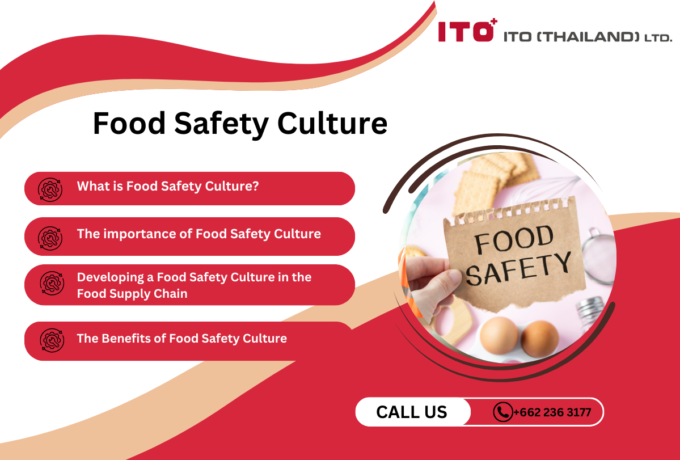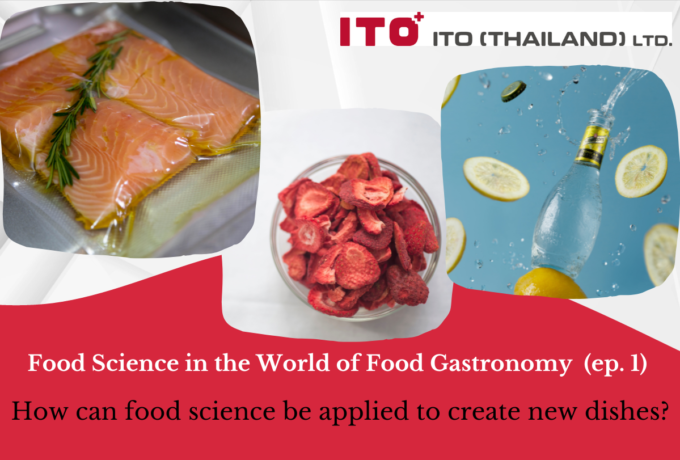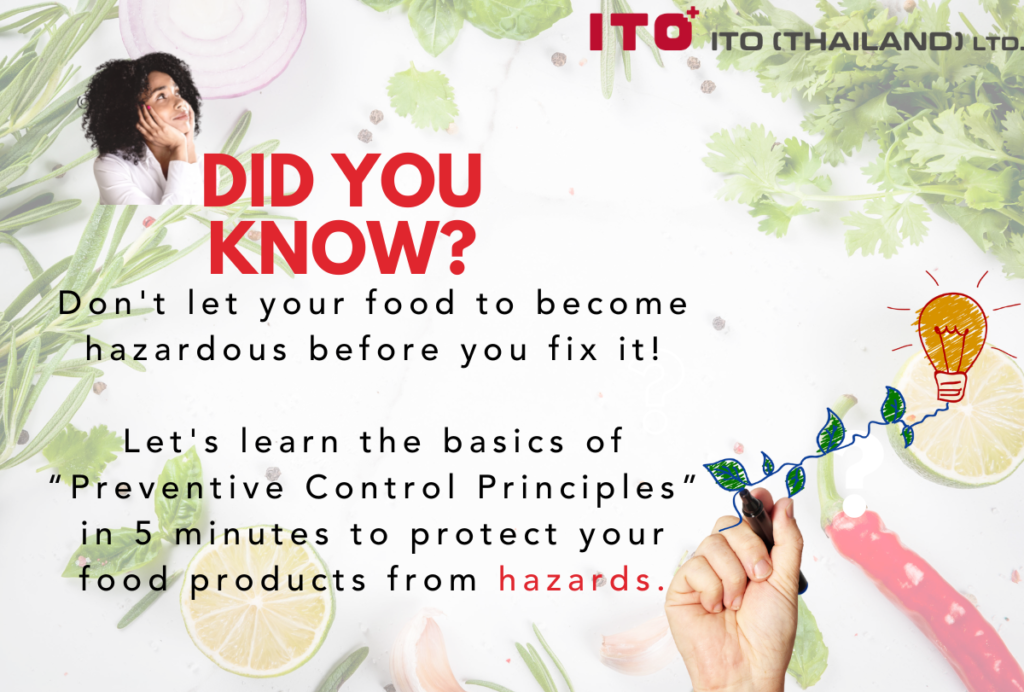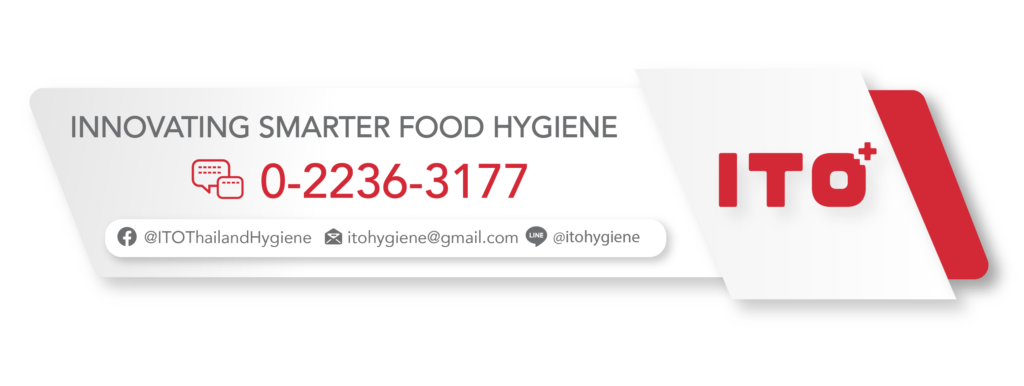ITO Thailand Hygiene Blog
Preventive Controls for Human Food (PCHF)
Preventive Controls for Human Food: Updated new principles to prevent your food from hazards
Don’t let your food to become hazardous before you fix it! Let’s learn the basics of “Preventive Control Principles” in 5 minutes to protect your food products from hazards.
Familiarize yourself with the preventive controls and relevant laws
PCHF are part of the Food Safety Modernization Acts (FSMA) (1) of USFDA or The United States Food and Drug Administration (read the full version here). The preventive controls are part of Section 103 under FSMA Final Rule for Preventive Controls for Human Food (2) which comprises Good Manufacturing Practices (GMP) (read more), hazard analysis (read more), and risk-based preventive controls.
The preventive controls focus on “preventing” the problems, not solving existing ones. They are implemented to minimize risks of food hazards after performing GMP and hazard analysis.
What do PCHF regulate?
The design of preventive controls as written practices will be different for each organization depending on the type of food, features of the production process, and various factors. However, in principle, preventive controls can be divided according to control objectives as follows:
•Process control: The controls in this part include heating, freezing, acidification, sterilization, drying, storage of raw materials, foreign matter sorting, chemical control in food recipes or any action taken to ensure food safety. The parameters and acceptance limits must be clearly measurable (e.g., time, flow rate, viscosity, moisture, concentration, acidity, size, etc.) and a method to control the parameters to meet these limits. In many cases, it is the same as hazard analysis and control in a HACCP standard.
•Food allergen control: Allergens are another issue of greater importance in food safety control because there are some groups of consumers who are allergic to certain proteins in food and that induces allergic reactions harmful to the body (read more). For this section, organizations must have written procedures for controlling cross-contamination of allergens and proper labeling of potential allergenic ingredients.
•Sanitation control: Sanitation control is the design of methods, practices, regulations, or associated processes to keep production conditions clean, reduce or eliminate hazards (e.g., environmental contamination of pathogenic microorganisms, cross-contamination (microorganisms and allergens) and employee operational hazards) that may occur. The control includes planning or designing buildings, determining the risk level of food production areas, determining appropriate cleaning and disinfection methods, setting up the dress code, and measures to prevent human contamination, etc.
•Supply chain control: Nowadays, many product problems are caused by the error of the manufacturers (suppliers) who supply contaminated or hazardous raw materials which are then used in the production, and it causes harm to the consumers. Therefore, this preventive control focuses on controlling the receipt of raw materials or products from manufacturers. There must be a process to verify that the manufacturers who produce raw materials have good production process standards, the appropriate certificates, and undergo a regular inspection or assessment whether to ensure that the production standards are maintained.
•Recall plan: In addition to the manufacturer inspection, paying attention to product recalls to protect consumers before further hazards occur is another vital part. Therefore, there must be a plan outlining the steps to take if there is a problem to protect consumers as well.
•Other controls not previously specified but are necessary to reduce or eliminate potential hazards.
At present, the practical guidelines for preventive controls are still being drafted. You can study more here.
We, Ito (Thailand), are pleased to take part in elevating food industry standards so that Thailand stays in a sustainable food safety society. If you are interested in cleanliness and sanitation controls, you can contact us to discuss the problems and design a solution to suit your organization specifically.
Reference
Related Post
-

Food Safety Culture
Food safety culture plays a crucial role in safeguarding the company's reputation, ensuring the well-being of its employees, and providing a safe experience for its customers.
-

New food source safety issues
What are safety issues worth knowing for trendy new food sources like plant-based and insect-based proteins?
-

British Retail Consortium (BRC) Standard
Food safety management systems play a vital role in ensuring the production and distribution of safe and high-quality food products to consumers. With the global food supply chain becoming increasingly complex, food businesses must implement effective systems prioritising safety, quality, and compliance with industry standards. A food safety management system encompasses a set of procedures, processes, and controls designed to identify, prevent, and manage potential hazards at every stage of the food production and supply process. This proactive approach not only safeguards consumers' health but also protects the reputation and credibility of food companies in an ever more competitive market.
-

Food Science in the World of Food Gastronomy (Part 1)
How can food science be applied to create new dishes?
-

FSSC 22000
Food manufacturers must ensure food safety standards and processes. FSSC 22000 is an official certification program for Food Safety Management Systems (FSMS) recognised by the Global Food Safety Initiative (GFSI). This certification scheme offers a set of guidelines and procedures to ensure uniformity, openness, and safety across your entire supply chain. It applies to all companies operating within the food and beverage industry, ranging from farmers to retailers. By fulfilling the necessary criteria and obtaining FSSC 22000 certification, it is demonstrated that the required standards for food quality and implementing effective processes to manage and mitigate risks associated with food fraud, foodborne illnesses, expensive recalls, and other external threats are met.
-

Food Safety Aspects of Artificial Sweeteners
Artificial sweeteners, also known as sugar substitutes, non-nutritive sweeteners, or high-intensity sweeteners, are artificially produced compounds utilised in place of sucrose (table sugar) to add sweetness to food and drinks. Due to their significantly higher sweetness than regular sugar, only a fraction of artificial sweeteners (200 to 20,000 times less) is required to achieve an equivalent level of sweetness. Since the caloric contribution of these sweeteners, when used in such small quantities, is insignificant, they are often referred to as non-nutritive (4).










